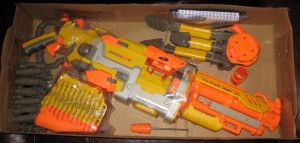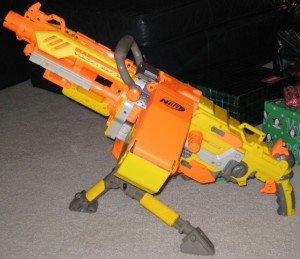| Caliber | 10 mm x 70 mm NERF |
| Operation | Electric (full-auto) or pneumatic (pump) |
| Cyclic rate | 180 rpm (depending on charge) |
| Feed | 25 round belt |
| Weight | 7.5 lbs |
| Dimensions | 30.5” long x 8.5” high x 14” wide (without tripod) |
| Barrel | Smoothbore |
| Barrel length | 12.5” |
| Sights | Post front, limited adjustment for elevation; fixed notch rear |
| Finish | Orange and yellow |
| Furniture | Plastic |
| Optional accessories | Tactical rail accommodates N-Strike line |
| Price | $54 (MSRP), $40 (street) |
| Manufacturer | Hasbro |
The Nerf N-Strike Vulcan EBF-25 is Hasbro’s first attempt at a Squad Automatic Weapon (SAW). It was a surprise to many people that a company specializing in handguns and rifles, with no previous experience in the full-auto realm, would even compete for the contract, and there was considerable controversy when Hasbro won the competition. Our testing and evaluation showed many rough edges on the EBF-25; we hope that these are just early production issues that will be ironed out in the field.
The EBF-25 fires the NERF standard 10 mm x 70 mm projectile; because hollowpoint rounds are banned by the Geneva Convention, only plastic round-nose projectiles are available in this chambering. Users in the sandbox have expressed concerns with the knock-down ability of this caliber; one anonymous user was quoted as saying
…you get some guy hopped up on Sour Skittles and Pop Rocks, unless you get in a lucky head shot, you’ve got to put the better part of a belt into him. With our older weapons, one, two rounds center of mass would put down anyone.
The EBF-25 comes disassembled and packed in a standard cardboard box. (There are rumors of a Pelican case, to be deployed Q1 2010, but Hasbro refuses to confirm or deny this.) Hasbro’s estimate is that a skilled armorer should be able to assemble the weapon in 10 to 15 minutes; our armorer took closer to 35 minutes from unpacking to test firing. Much of that time was spent undoing wire ties from the packaging.
 Disassembled EBF-25, as shipped.
Disassembled EBF-25, as shipped.
 Assembled EBF-25, with tripod.
Assembled EBF-25, with tripod.
The EBF-25 ships with a tripod mount; in use, we found the mount rather flimsy and prone to detaching from the weapon. While the tripod is optional, the EBF-25 cannot be fired effectively as a hand-held weapon; the awkwardly positioned carrying handle, as well as the weapon’s size and weight, make it all but impossible to fire at eye level. Firing from the hip looks impressive, but isn’t effective from a rounds-on-target perspective.
We found the general flimsiness of the tripod to extend to the rest of the EBF-25 as well. The ammo box frequently falls off (though the weapon can be fired without it), and the general fit and finish of our sample unit showed signs of hasty production.
Without a chronograph, we were unable to get accurate muzzle velocity figures. Our estimate is that the EBF-25 shoots the 10 mm projectiles at 30 fps; assuming the projectiles weigh about .5 grams, that gives a muzzle energy of 0.015 foot-pounds.
Since the EBF-25 barrel lacks rifling, and the projectiles lack fins, there’s nothing to stabilize them in flight; as you might expect, accuracy suffers. While it is difficult to measure group size with the NERF projectiles, we found that the weapon was capable of keeping five rounds in a six-inch group at approximately 30 feet. The sighting system (front blade with limited elevation adjustment, rear notch) is crude, but sufficient given the weapon’s design and purpose, and delivers roughly minute-of-person accuracy. The smaller, non-fin stabilized projectiles are probably less affected by wind; however, due to weather conditions, all of our testing was done on an indoor range.
The EBF-25 operates on a unique combined electric/pneumatic system. The weapon can be operated in a pump-action mode for single shots; however, the EBF-25 design makes this awkward. The weapon is truly designed to be used in the electrically operated full-auto mode. A switch on top of the weapon’s pistol grip serves as a combination on/off switch and safety. Full-auto operation is a matter of turning the switch to “on” and pulling the trigger. Hasbro quotes a cyclic rate of three rounds per second, or 180 rounds per minute, but this is dependent on battery charge. The weapon uses 6 “D” size batteries. The changing process requires a Phillips screwdriver for access to the battery compartment; we estimate approximately ten minutes for a battery change in the field. We were unable to determine how many shots a single set of batteries is good for, due to our limited hands-on time with the weapon. Clearly this depends on ambient temperature, battery age and quality, and other factors. In our testing, we were able to put about 200 rounds, spread out over about 12 hours, through the weapon on a single set of “D” batteries with no noticeable slowdown in cyclic rate.
The 10mm rounds are fed from a plastic belt holding a maximum of 25 rounds. The EBF-25 comes with a plastic ammo box that attaches to the side of the weapon and holds the belt; we found the box was not well secured and detached easily from the weapon. While extra belts are available, there is no supported way to link multiple belts together for additional capacity. During our tests, we experienced no jams or misfires.
One handy feature of the EBF-25 is the two tactical rails, running to the right and left of the barrel. These rails allow for the mounting of any NERF N-Strike standard tactical accessories, such as the EX-6 Kit.
Our sample unit was obtained on sale for $40 at Fry’s Electronics. We have heard rumors of prices as low as $30, but have not found a dealer with units in stock at that price. Since this is a smoothbore foam-based weapon, a Class III license and payment of a transfer fee are not required.
The EBF-25 represents the future of infantry weapons (at least for the next 364 days). Some of the problems with the unit (fit and finish, general build quality) may be worked out in future production runs. Other problems (the effectiveness of the 10 mm round) are limitations imposed by the desire to standardize on a single caliber for all operational units, and won’t be fixed in the near future. We do hope that the limited ammo capacity and reliance on batteries is addressed in the near future, either by Hasbro or third parties.
Our boys in the field deserve the best possible SAW; the EBF-25 is a noble effort, but falls short of that goal.
(Thanks and apologies to Peter G. Kokalis.)
Having observed the weapon in action for the last 24 hours, I completely agree with your assessment. Ironically, the “non-auto” mode of the weapon tends to jam MUCH more than in auto.
That said, the accuracy of this weapon is not much worse than the rest of my son’s arsenal, and the automatic fire provides a spread that assures a hit in a one-on-one situation.
We have four of them. Pretty cool, but they jam all the time. Heck, they jam before you even shoot it.
At least all of yours are still working. Mine, not so much. There’s some kind of a plasticky rattle inside, and the belt won’t feed anymore, either manual or automatic. Sounds like a busted gear or something similar. Field stripping is almost impossible due to the handle on top that is permanently captured.
BTW, loved the review. Awesome!
The handle actually can be taken apart. I just did mine, so i can run a 22.2V external battery. you take the 6 screws out of the handle, and then GENTLY wedge a flat-blade screwdriver and pop that thing apart. then, you just pop it out.